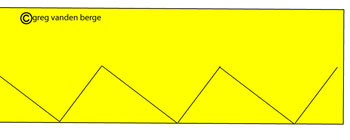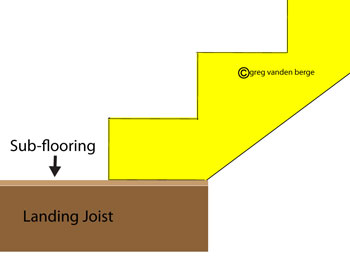How To Layout Bottom of Stringer For Landing
There are a few ways you can layout the bottom of a stair stringer for a landing. We're only going to cover one of them on this page and it's going to be similar to the one you should already understand on calculating and adjusting the first tread.

We are going to start with a stair stringer with all of the tread and riser marks already laid out. For more information on how to lay out these marks, go back and revisit the page, how to layout and mark stair stringer.

This measurement is critical and should be calculated
and adjusted perfectly, otherwise you're going to have problems with the
first step on the landing.
You will need to deduct the vertical tread height or thickness from the
bottom of the stair stringer.
For example, if the risers for your stairway are seven and three-quarter
inches tall and you're going to use construction standard lumber
measuring an inch and a half in thickness, then you will need to deduct
an inch and a half from the over all riser height.
7.75 - 1.5 = 6.25
7- 3/4 inch riser height (minus) 1 - 1/2 construction standard 2 x 6
(equals) 6 1/4 inches.

This is what the finished stringer should look like, before it's attached to the stair landing.

The illustration above provides you with an excellent example of what the stair stringer would look like if it was sitting directly on top of a stairway landing.
Back To How To Do It Yourself / How To Figure And Calculate Stair Stringers / How To Layout Bottom of Stair Stringer


